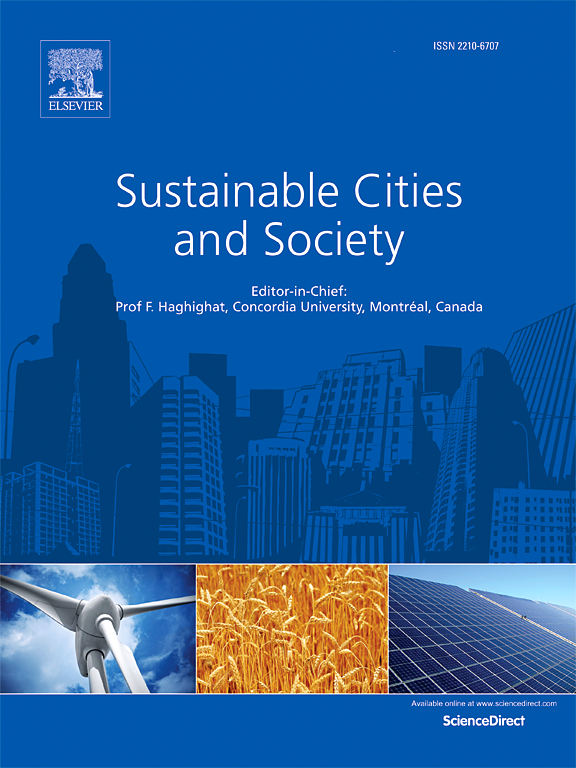Examining the influencing factors of green transformation efficiency in resource-exhausted cities through the lens of Chinese case studies: A framework integrating urban system composition analysis and PLS-SEM methodology
IF 10.5
1区 工程技术
Q1 CONSTRUCTION & BUILDING TECHNOLOGY
引用次数: 0
Abstract
In resource-exhausted cities, improving the efficiency of green transformation requires analysis of influencing factors and action paths. DEMATEL-ISM method and MICMAC model were used to analyze the dependence and driving force of five influencing factors. Based on PLS-SEM model, the hierarchical structure and action path of the influencing factors were quantitatively analyzed through 39-sample cities in China. Simultaneously, the relationship between spatial form and Urban Green Transformation Efficiency (UGTE) and its reasons are qualitatively analyzed. The main conclusions are as follows: (1) The urban spatial system affects urban productivity. (2) Economy, environment, and infrastructure are highly interdependent, with minimal driving force. In contrast, society and space have a larger driving force and are less dependent. (3) In resource-exhausted cities, economy has the greatest impact on UGTE (0.367***), followed by infrastructure (0.358***) and environment (-0.160***). The path coefficients of spatial impact on economy, environment, and infrastructure were 0.337, 0.741, and 0.564, respectively. The path coefficient of social influence on economy is 0.564***. (4) The UGTE of radiation and centralized urban spatial forms is higher. The UGTE of band and group urban spatial form is lower. The theoretical contributions of this study are as follows: (1) for the first time, an analysis framework that includes spatial factors influencing UGTE is proposed; (2) the study explores sustainable urban form and establishes a research paradigm for related studies. The practical contributions include providing guidance for the medium- and long-term spatial planning of different resource-based cities. For example, resource-exhausted cities in the decline stage should adopt a compact spatial form of functions. This study has some limitations: (1) the regional heterogeneity of spatial form is not considered; (2) the urban spatial system evaluation method has room for optimization; (3) the potential impact of the location of urban spatial elements on UGTE has not been discussed.
基于中国案例的资源枯竭型城市绿色转型效率影响因素研究——基于城市系统构成分析与PLS-SEM方法的整合框架
在资源枯竭型城市,提高绿色转型效率需要分析影响因素和行动路径。采用DEMATEL-ISM方法和MICMAC模型对5个影响因素的依赖性和驱动力进行分析。基于PLS-SEM模型,以中国39个城市为样本,定量分析了影响因素的层次结构和作用路径。同时,定性分析了空间形态与城市绿色转化效率的关系及其产生原因。主要结论如下:(1)城市空间系统影响城市生产力。(2)经济、环境、基础设施相互依存程度高,驱动力低。相比之下,社会和空间的驱动力更大,依赖性更小。(3)在资源枯竭型城市中,经济对UGTE的影响最大(0.367***),其次是基础设施(0.358***)和环境(-0.160***)。经济、环境和基础设施空间影响路径系数分别为0.337、0.741和0.564。社会对经济影响的路径系数为0.564***。(4)辐射型和集中型城市空间形态的UGTE较高。带状和组团城市空间形态的UGTE较低。本研究的理论贡献主要体现在:(1)首次提出了包含空间因素影响UGTE的分析框架;(2)探索可持续城市形态,为相关研究建立研究范式。实际贡献包括为不同资源型城市的中长期空间规划提供指导。例如,处于衰退期的资源枯竭型城市应采用紧凑的功能空间形式。本研究存在以下局限性:(1)未考虑空间形态的区域异质性;(2)城市空间系统评价方法有优化空间;(3)城市空间要素区位对UGTE的潜在影响尚未讨论。
本文章由计算机程序翻译,如有差异,请以英文原文为准。
求助全文
约1分钟内获得全文
求助全文
来源期刊

Sustainable Cities and Society
Social Sciences-Geography, Planning and Development
CiteScore
22.00
自引率
13.70%
发文量
810
审稿时长
27 days
期刊介绍:
Sustainable Cities and Society (SCS) is an international journal that focuses on fundamental and applied research to promote environmentally sustainable and socially resilient cities. The journal welcomes cross-cutting, multi-disciplinary research in various areas, including:
1. Smart cities and resilient environments;
2. Alternative/clean energy sources, energy distribution, distributed energy generation, and energy demand reduction/management;
3. Monitoring and improving air quality in built environment and cities (e.g., healthy built environment and air quality management);
4. Energy efficient, low/zero carbon, and green buildings/communities;
5. Climate change mitigation and adaptation in urban environments;
6. Green infrastructure and BMPs;
7. Environmental Footprint accounting and management;
8. Urban agriculture and forestry;
9. ICT, smart grid and intelligent infrastructure;
10. Urban design/planning, regulations, legislation, certification, economics, and policy;
11. Social aspects, impacts and resiliency of cities;
12. Behavior monitoring, analysis and change within urban communities;
13. Health monitoring and improvement;
14. Nexus issues related to sustainable cities and societies;
15. Smart city governance;
16. Decision Support Systems for trade-off and uncertainty analysis for improved management of cities and society;
17. Big data, machine learning, and artificial intelligence applications and case studies;
18. Critical infrastructure protection, including security, privacy, forensics, and reliability issues of cyber-physical systems.
19. Water footprint reduction and urban water distribution, harvesting, treatment, reuse and management;
20. Waste reduction and recycling;
21. Wastewater collection, treatment and recycling;
22. Smart, clean and healthy transportation systems and infrastructure;
 求助内容:
求助内容: 应助结果提醒方式:
应助结果提醒方式:


